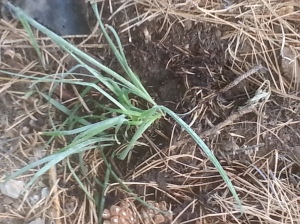I moved some bunching onions to new raised bed 8 late yesterday and watered them in with mucilagenous water made with one small prickly pear pad (5″).
I made 5 clumps from one, kept a couple to eat, and replanted in our hottest weather. It seems like a good test for mucilagenous watering.
This morning they are looking better than after planting, so the transplant seems like it will take. Onions are easy transplants, and I did want to shift some to this bed. Some these have bloom buds on them, and they look like they might bloom even though I transplanted them. The bunching onions will get a half day sun here.
I will make more mucilagenous water to give root support to a few more plants. At least I hope it is a support! If it increases my success rate with non native plants, I will count it a winner.



What is ‘mucilagenous’ water? What are its benefits?
Hi Helen,
It is an experiment I am conducting. Read Tree Chola for the outline. Mucilagenous plants have a lot of mucilage, plant roots make mucilage to hold water to the roots and to facilitate root movement through soil. Desert plants frequently use mucilage in their leaves and stems to hold water. I have trouble with outside plants because they do not have enough mucilage. I increased my mucilage intake because of smoke from the forest fire. I think adding a little mucilage to soil around new plantings might be another way to help them survive while developing a deeper root system. It can hold the water in the soil and slow drainage. I have not read this anywhere, but I studied the plant-soil interface in school. It just occurred to me and I am trying it. I will sacrifice another mucilagenous prickly pear pad today for another plant. I have a huge amount of them and will test this theory out.
I also wonder if it can increase the plant’s internal mucilage just like it does ours. For us, mucilagenous plants improve our mucus membranes, our first line of defense against bacteria, viruses, toxins. This part comes from my current studies on herbal medicines, many of which support body functions.
It is interesting to try, even though I do not have scientific equipment for measurable results, I can see whether it improves my survival factor on non native plants so they can establish root systems capable of supporting themselves.
Thanks for your answer. I hope your experiment works.
I guess Aloe Vera is good because of the benefits you describe?
In part, it is one of the many benefits of Aloe. Aloe has a lot of nutrients also. Helpful as a rebuilder. More plants got a shot of mucilagenous water late yesterday. I will take more out later. I am enjoying reading medical research papers, and herbal information and chemistry and adding it to plant knowledge. Not likely to run out of things to study.
No, always more to study (in any field).
Helen,
Clearly I miss the research aspect of my former career as a paralegal.